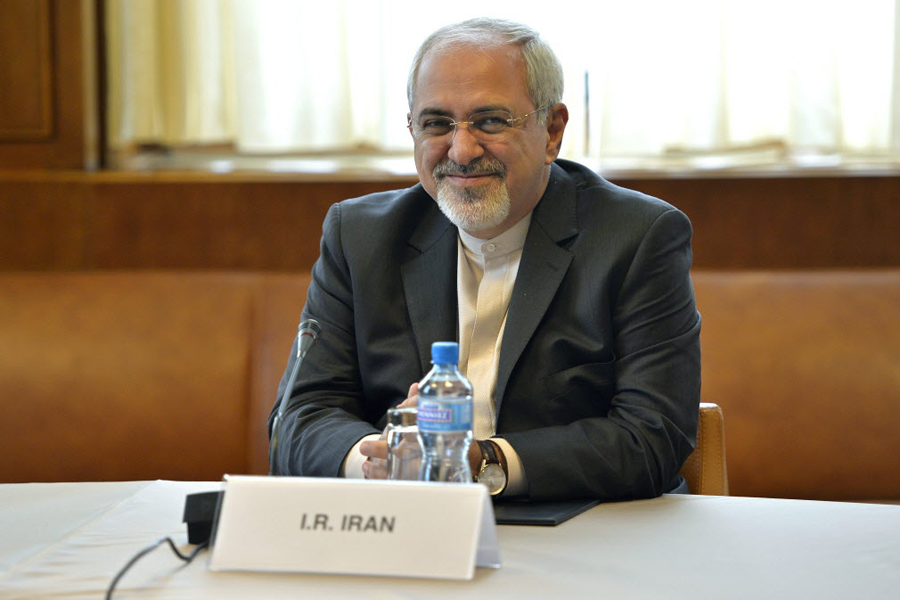Iran: Don't blame us, blame our tea party
Loading...
| Geneva
The banners that sprung up in Tehran had one purpose: to undermine Iran’s nuclear talks, and ruin chances of future reconciliation with the US.
One showed an Iranian negotiator, intended to represent Foreign Minister Mohammad Javad Zarif, sitting across from an American, who under the table and out of sight wore a holstered gun and military camouflage trousers.
The words on the banner accused the US of deception, and doubled as a veiled attack on those Iranians willing to negotiate. The banners – removed a few days later – are a reminder that Iran has its "spoilers," too, Foreign Minister Mohammad Javad Zarif said a few days later.
“You said we don’t have a tea party? I wish you were right,” he said.
A tea party in Iran?
Since Iran’s 1979 Islamic revolution, a hard-line group of Iranians have scored points against political rivals, sometimes putting at risk broader national policies for their gain. In some Iranians' eyes, that makes them a perfect comparison for the American “tea party” that recently spearheaded a US government shutdown.
A few days after the banners were taken down, Iranian hardliners gathered at the former US embassy in Tehran to chant “Death to America!” and burn US flags to mark the anniversary of the seizure of the US Embassy in Tehran in 1979.
A senior US official, speaking days after the banners were taken down, said they understood the dynamic.
“Iran is a culture with many elements in it, as is ours. We have hardliners in our culture – probably not hardliners like Iranian hardliners, but a different variety,” said the US official, speaking on the eve of nuclear talks in Geneva.
In Iran, the “tea party” takes two forms. The political, hard-line groups that adhere to the anti-Americanism of the early years of the Iranian revolution, and for whom “compromise” is a dirty word, are one type. They fight with words, from the Friday prayers pulpit, on air and in print.
Among them might be Kayhan newspaper, which misreported that Zarif had privately said President Hassan Rouhani’s historic telephone call with Barack Obama was a “mistake.” The inaccurate headline alone was enough to send the foreign minister to the hospital with back and leg spasms. Zarif made clear that he thought the accusation was deliberate.
“It was a bitter but very informative day for me,” he wrote on his Facebook page. “I learned that whatever I want to say, to say it publicly, because otherwise the market for abuse is very active.”
There is another spoiler element in Iran whose actions put it far beyond any tea party comparison. Vigilante pressure groups, which traditionally use violence, got their start in the 19th century as “enforcers” tasked with carrying out the religious decrees of imams in Iranian villages. They were later used by the pro-West Shah before his toppling in 1979. In one case, he set up a vigilante force staffed by policemen in civilian clothes, which attacked meetings organized by students and other “dissidents.”
The violent tactics evolved further after the revolution, and vigilante groups became instrumental in intimidating and attacking – often wielding chains and clubs – pro-reformist supporters of President Mohammad Khatami. In 1995, the shadowy Ansar-e Hezbollah (Followers of the Party of God), issued a manifesto with full-page newspaper ads which read: “Until our throats be cut, we will fight the supporters of the West and of anti-fundamentalist tendencies.”
Some would credit their influence with helping to destroy Khatami's presidency, which had unprecedented popular support among voters, and ending Khatami's outreach toward the US.
Similar groups have operated outside Iran, essentially freelancing, often secretly and in what they claim to be the name of the revolution, but beyond central government control. The takeover by militants of the British Embassy in late 2011 is one example that deepened Iran's isolation and painted Iran as a nation where street violence can rule.
And that was hardly the first time. The 1988 resignation letter of the then-Prime Minister Mir Hossein Mousavi, for example, complained that his authority had been “taken away."
“Only after an airplane is hijacked are we made aware of it,” wrote Mr. Mousavi, whose 2009 presidential bid sparked the Green Movement uprising and years of house arrest. “Only after a machine gun opens fire in one of Lebanon’s streets and its noise echoes everywhere do we find out. Only after [Saudi police] find explosive material in Iranian pilgrims’ baggage am I informed.”
[Editor's note: The original story misidentified the name of former president Mohammad Khatami.]






